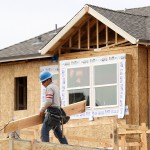Digging Around for the Roots of Idaho’s Foreclosure Rate
The Idaho housing market’s boom and bust is sure to be a long-term focus here at StateImpact. RealtyTrac’s August numbers, out last week, show that Idaho has the fifth highest rate of foreclosure in the nation. The Boise area has seen the worst of it, with foreclosures concentrated in Ada and Canyon Counties. There, filings are a daily occurrence.
Idaho’s housing boom was concentrated around its two main metropolitan areas, Boise and Coeur d’Alene. John Starr of the global real estate company Colliers International had a front-row seat as capital poured into the local market in the years preceding the bust. When he thinks of the early 2000s, he remembers watching land prices rise with demand, and house lots shrink. What the area wound up with, he says, were more and more subdivisions, packed tight with houses. Now, many of those homes stand vacant.
In Starr’s analysis, the decision by big banks and out-of-state developers that Boise was a good place to put money has a lot to do with Micron Technology. When Micron took off in the early 1990s, other employers were drawn to the state. Idaho boomed. Census data show that the state’s population grew by more than 28 percent from 1990 to 2000, and by more than 20 percent from 2000 to 2010. To housing developers looking for places to invest, Idaho was a gem. But Starr says they should have looked closer.
“The reason we were doubling the national average growth rate was we were moving in a whole bunch of people that we couldn’t produce here in Idaho, namely electrical engineers and so forth to work at Micron,” he said. “The data points that people were looking at that were helping them make decisions about coming to Boise and deploying capital and building and helping us grow – those data points were skewed.” In 2003, Micron announced plans to lay off 10 percent of its worldwide workforce. More cuts would follow.
According to Metrostudy, a housing and data information company, Boise’s housing market began to bottom out in 2009. Housing starts are now at an all-time low of 1,172. John Starr and others think the area’s foreclosure problem will persist for at least several more years.
Like a lot of people in his line of work, local real estate agent Tom Koltes has had to shift his focus in the wake of the housing market’s collapse. In the years before the recession, his primary focus was new construction. “I did subdivisions, lots, and then builders in those subdivisions,” he said. Now Koltes helps troubled homeowners offload their properties through short sales, and works with prospective buyers who want to get a good deal on a foreclosed property. “Where the market was going was growth,” he said. “Obviously now it’s picking up the pieces of too much growth all at once.”

